How To Get Rid of Woodpeckers
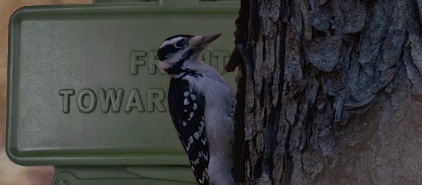
 oodpeckers may be cute, but they make lots of noise and drill large,
ugly holes in your wood siding. You need to take care of woodpeckers as
soon as they appear, before it becomes a habit for them. This means prevention.
In practical terms, it means that you must continue to take precautions
after they've been driven off, or they will eventually return.
oodpeckers may be cute, but they make lots of noise and drill large,
ugly holes in your wood siding. You need to take care of woodpeckers as
soon as they appear, before it becomes a habit for them. This means prevention.
In practical terms, it means that you must continue to take precautions
after they've been driven off, or they will eventually return.
Woodpeckers drill small holes (up to 1/2 inch in diameter) when looking for food. When they drill large holes (2 to 3 inches in diameter) they are trying to create a nest. Nesting occurs mostly in the autumn (October–November) before it gets cold.
The best way to prevent food holes is to have the house sprayed with insecticide. A common problem is carpenter bees, which are evident by small holes about 1/8 inch in diameter. Bees will hover in front of the wall, searching for these holes. After spraying, it is usually necessary to seal the holes to prevent reinfestation.
Drilling of nesting holes can be discouraged by installing reflective strips and sound deterrents (see below). However, the most effective way is to physically prevent them from accessing the wall by installing a bird net.
Shooting them
Shooting the little bastards is probably the most obvious way to get rid of them, but aside from being not very nice, it suffers from two practical disadvantages: one, it's illegal, and two, it creates even more holes in your wood siding, which rather defeats the purpose. Standing outside your house with a shotgun for hours at a time looking up at the roof is also a good way to get arrested in many areas.
Likewise, poison and trapping are illegal in most places. Exterminators will generally refuse to do anything except spray for insects. Spraying is done in the spring, after they hatch.
Reflector tape
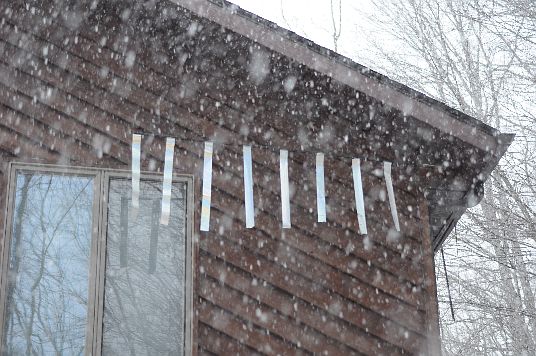 Reflector tape attached to a brown piece of screen frame. One end of the screen frame
is bolted to an aluminum bracket which is attached to a piece of wood screwed into
the corner post.
Reflector tape attached to a brown piece of screen frame. One end of the screen frame
is bolted to an aluminum bracket which is attached to a piece of wood screwed into
the corner post.
Reflector tape frightens the birds and is highly effective. The 2-inch wide type is better because it makes noise and doesn't get tangled up when it gets windy. If you've ever been 40 feet up on a ladder trying to work while this tape is dangling near your head, you will understand why it frightens them. It's noisy and disorienting. In fact, most things that make humans nervous will generally frighten birds. However, there are limits. Telling birds their property taxes are going up or their credit card has been canceled generally has little or no effect.
The reflector tape should be cut into 2-foot long strips and attached to a piece of screen frame about two feet apart with a 2-inch piece of spline. Attach the screen frame about a foot down and one foot out from the wall so the wind can't blow it up onto the roof. Don't use duct tape—it will leave a residue on your gutter or soffit.
Does it work?
Yes—it looks tacky, so woodpeckers, sophisticated connoisseurs that they are,
will generally stay at least six feet away from it to avoid being associated with
such a tacky display. Unfortunately, if your house is more than 8 feet high, this
means parts of it will still be unprotected.
Bird glue / spikes / plastic owls / repellent
Bird glue is a form of glue that is sold to repel birds. It's not strong enough to entrap them, but they dislike the sensation and avoid it. However, you can't cover your entire wall with it. This stuff is better for pigeons, who typically land on a narrow balcony. Same with bird spikes.
Plastic owls have little effect other than to create a small physical barrier of a few square inches. Since they aren't flat, woodpeckers can easily reach around behind them.
However, the neighborhood stray cats find them fascinating. Whenever I put a plastic owl in the window, I always see cat tracks in front of it the next day. Anything that attracts cats is good, but getting the cats up to where the woodpeckers are can be a challenge.
There used to be a product called woodpecker repellent that was supposed to create a bad odor that deters them from re-drilling the hole again. These sprays have mostly been taken off the market because they don't work.
Animated Plastic owls
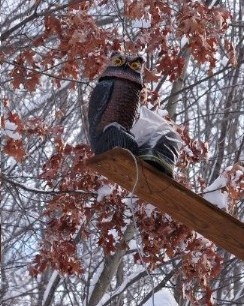 Plastic animated owl and speaker. This particular model of owl is no
longer made.
Plastic animated owl and speaker. This particular model of owl is no
longer made.
Owls are universal symbols of wisdom ... and of the lack of woodpeckers.
Animated plastic owls that have photosensors built into their base are more effective at frightening away woodpeckers. Whenever there is a bird-like disturbance, these animated owls make a hooting sound and rotate their head toward it. Unfortunately, they're made in China, which means you have to take them apart and rebuild them before they're useful.
These owls have to be bolted down to keep them from blowing away. I drilled two holes in the back and inserted a ¼-inch thick steel L-bracket inside the owl. I attached the bracket to the owl with two ¼-20 bolts and large washers to keep the cheap plastic from breaking apart.
The sensors, of course, cannot really detect birds, but they will be set off by moving leaves and, especially, by reflector tape. Most of the time, these owls just sit there and do nothing. But when the sun hits the reflector tape, the electronic owl goes crazy, hooting continuously and spinning its head around in endless circles. This convinces the birds that a crazy person lives in the house, and they will avoid it.
It is easier to set up a computer to play .WAV files of screech owl sounds at random intervals through an outside speaker. This gives a wider variety of owl sounds, and a much more realistic sound quality as well. But what you end up with is an owl that hoots once every hour: a cuckoo owl.
A cuckoo owl is never 100% effective, but it increases the effective range of tape. The best place is a platform in the middle or upper part of the wall, at least fifteen feet above the ground. If it's too low, or if it's too hard to see, it will not register in their brain as a real owl.
Bird Distress Call Generators
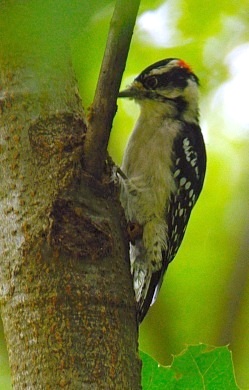 The culprit: a Downy Woodpecker
The culprit: a Downy Woodpecker
Birds make distinctive noises when injured, or when there are snakes or other hazards around. Bird distress call generators like the BirdXPeller Pro from Bird-X play recorded distress calls from a variety of species. They're expensive, but a couple hundred bucks is a small price to pay to protect your wood siding. Unlike those animated plastic owls, Bird-X's are very well made, and they make very realistic sounds which are recordings of a variety of distress calls and predator sounds.
The WP version is designed for woodpeckers; it has four predators (none of which are owls) and a woodpecker distress call. I don't know about woodpeckers, but my oh my, did the neighborhood birds go quiet when I first turned it on.
The manual says the sound is on a random timer, but it also has a photocell that turns the sound off at night. By random the manufacturer means the order in which the sounds are played. For example, every 6−8 minutes, the unit plays all the sounds in random order, one after the other. You can select the time interval and which sounds to play using the little DIP switches.
It has a 1/8-inch mini phone connector for an external speaker, but it requires a special $82 75Ω speaker. A regular outdoor speaker will not work.
Does it work?
I located a Bird-X five feet away from where the woodpeckers were drilling. Even
at full volume it had no effect on them. But after a few days, they stopped coming
back. However, by then they had drilled so many holes that it had clearly
failed in its task.
The Bird-X is extremely loud. At full volume, peak sound pressure levels can reach 100 dBA. I suspect this is an underestimate, and that much of the sound is in the ultrasonic range. So it's not clear whether the effect is due to the distress calls, or whether it's just hurting their ears. Whatever it's doing, it seems that, decibel for decibel, it seems that a distress call is much less effective than an owl sound.
Real owls
What about a real owl? If you live in a rural area with lots of trees, you could set up an owl box. It should be set up some distance away from your house, because owls will not hunt right next to their nest box.
Bird Netting
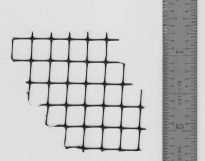 Industrial Netting OV7822 42×100 netting. Scale is inches.
Industrial Netting OV7822 42×100 netting. Scale is inches.
Bird netting is fine plastic netting that is attached three inches from the wall. Nixalite has lots of details about how to install it. Netting serves as a physical barrier, so it's 100% efficient at protecting the area that it covers, so it's necessary to cover the entire wall.
There are many good kinds of bird netting on the market; I use Industrial Netting OV7822 42×100 netting, which is ¼×¼ inch black plastic netting. This plastic is less flexible than woven nets, so it's less floppy and holds its shape better and it's light enough to be suspended from aluminum U-channels, aluminum rods, 3/16-inch stranded stainless steel cable, or even aluminum screen frames without sagging. The small grid size means leaves and birds don't get caught in it. It's invisible from more than three feet away. It comes in a 42-inch by 100-foot roll.
The support support is made by bending a ¼-inch thick aluminum flat into a J-shape using a torch. The channel is ¼ inch inside, so the support fits tightly, and it's secured in place with a 6-32 stainless steel screw. The hardest part is getting the price tag off so you can spray paint it.
My advice: for an occasional woodpecker, reflector tape is generally adequate.
If they're drilling small food holes, it means you need to have your house sprayed.
If the woodpecker comes back or starts drilling big nesting holes, don't waste your
time with plastic owls, sound generators, or other products—put up a net.
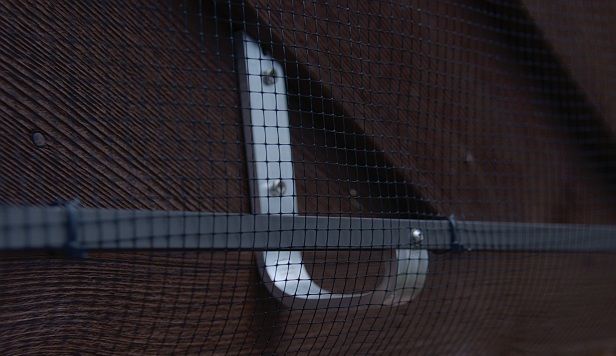 Bird net attached to wood siding using 3/8×1/2 inch 6063 aluminum U-channel
(wall thickness 1/16"). Stainless steel screws attach it to the siding and plastic
cable ties hold the net in place. The U-channel cost about 9 bucks for an 8 foot
length at a local hardware store.
Bird net attached to wood siding using 3/8×1/2 inch 6063 aluminum U-channel
(wall thickness 1/16"). Stainless steel screws attach it to the siding and plastic
cable ties hold the net in place. The U-channel cost about 9 bucks for an 8 foot
length at a local hardware store.
Summary
For occasional birds, a hooting animated owl in combination with the reflector strips may work. However, a net is more effective and looks more professional.
